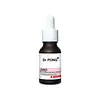What's inside
What's inside
 Key Ingredients
Key Ingredients

 Benefits
Benefits

 Concerns
Concerns

 Ingredients Side-by-side
Ingredients Side-by-side

Water
Skin ConditioningButylene Glycol
HumectantGlycerin
HumectantIsononyl Isononanoate
EmollientDiisostearyl Malate
EmollientPEG-20 Methyl Glucose Sesquistearate
EmulsifyingPhenoxyethanol
PreservativeAcrylates/C10-30 Alkyl Acrylate Crosspolymer
Emulsion StabilisingDipotassium Glycyrrhizate
HumectantChlorphenesin
AntimicrobialBisabolol
MaskingXanthan Gum
EmulsifyingPotassium Hydroxide
BufferingRetinyl Palmitate
Skin ConditioningDisodium EDTA
Helianthus Annuus Seed Oil
EmollientAloe Barbadensis Leaf Juice
Skin ConditioningMaltodextrin
AbsorbentPolysorbate 20
EmulsifyingCaprylic/Capric Triglyceride
MaskingHydroxypropyl Cyclodextrin
MaskingRetinol
Skin ConditioningPotassium Sorbate
PreservativeSodium Benzoate
MaskingSodium Metabisulfite
AntioxidantTocopherol
AntioxidantBHT
AntioxidantWater, Butylene Glycol, Glycerin, Isononyl Isononanoate, Diisostearyl Malate, PEG-20 Methyl Glucose Sesquistearate, Phenoxyethanol, Acrylates/C10-30 Alkyl Acrylate Crosspolymer, Dipotassium Glycyrrhizate, Chlorphenesin, Bisabolol, Xanthan Gum, Potassium Hydroxide, Retinyl Palmitate, Disodium EDTA, Helianthus Annuus Seed Oil, Aloe Barbadensis Leaf Juice, Maltodextrin, Polysorbate 20, Caprylic/Capric Triglyceride, Hydroxypropyl Cyclodextrin, Retinol, Potassium Sorbate, Sodium Benzoate, Sodium Metabisulfite, Tocopherol, BHT
Water
Skin ConditioningBiosaccharide Gum-1
HumectantHydroxyethylcellulose
Emulsion StabilisingHydroxypropyl Guar
Emulsion StabilisingNiacinamide
SmoothingHydroxyethyl Urea
HumectantGlycerin
HumectantGluconobacter/Honey Ferment Filtrate
Skin ConditioningSaccharide Isomerate
HumectantGlycine Soja Seed Extract
Skin ConditioningButylene Glycol
HumectantSilanediol Salicylate
EmollientGluconolactone
Skin ConditioningPotassium Azeloyl Diglycinate
Skin ConditioningCapryloyl Salicylic Acid
ExfoliatingSophora Angustifolia Root Extract
Skin ConditioningArbutin
AntioxidantAcetyl Tyrosine
Skin ConditioningSaxifraga Sarmentosa Extract
Skin ConditioningPaeonia Suffruticosa Root Extract
Skin ProtectingAminopropyl Ascorbyl Phosphate
AntioxidantScutellaria Baicalensis Root Extract
AstringentGlutathione
Allantoin
Skin ConditioningSodium Hyaluronate
HumectantLinolenic Acid
CleansingXanthan Gum
EmulsifyingPolyvinyl Alcohol
Glycolic Acid
BufferingLactic Acid
BufferingSodium Ascorbyl Phosphate
AntioxidantPalmitoyl Sh-Tripeptide-5 Norisoleucyl Sh-Nonapeptide-1
Skin ConditioningSodium Polyacrylate
AbsorbentEthylhexyl Stearate
EmollientTrideceth-6
EmulsifyingPolyacrylate Crosspolymer-6
Emulsion StabilisingHydroxyacetophenone
AntioxidantCaprylyl Glycol
EmollientDipropylene Glycol
HumectantDipotassium Glycyrrhizate
HumectantWater, Biosaccharide Gum-1, Hydroxyethylcellulose, Hydroxypropyl Guar, Niacinamide, Hydroxyethyl Urea, Glycerin, Gluconobacter/Honey Ferment Filtrate, Saccharide Isomerate, Glycine Soja Seed Extract, Butylene Glycol, Silanediol Salicylate, Gluconolactone, Potassium Azeloyl Diglycinate, Capryloyl Salicylic Acid, Sophora Angustifolia Root Extract, Arbutin, Acetyl Tyrosine, Saxifraga Sarmentosa Extract, Paeonia Suffruticosa Root Extract, Aminopropyl Ascorbyl Phosphate, Scutellaria Baicalensis Root Extract, Glutathione, Allantoin, Sodium Hyaluronate, Linolenic Acid, Xanthan Gum, Polyvinyl Alcohol, Glycolic Acid, Lactic Acid, Sodium Ascorbyl Phosphate, Palmitoyl Sh-Tripeptide-5 Norisoleucyl Sh-Nonapeptide-1, Sodium Polyacrylate, Ethylhexyl Stearate, Trideceth-6, Polyacrylate Crosspolymer-6, Hydroxyacetophenone, Caprylyl Glycol, Dipropylene Glycol, Dipotassium Glycyrrhizate
Ingredients Explained
These ingredients are found in both products.
Ingredients higher up in an ingredient list are typically present in a larger amount.
Butylene Glycol (or BG) is used within cosmetic products for a few different reasons:
Overall, Butylene Glycol is a safe and well-rounded ingredient that works well with other ingredients.
Though this ingredient works well with most skin types, some people with sensitive skin may experience a reaction such as allergic rashes, closed comedones, or itchiness.
Learn more about Butylene GlycolDipotassium Glycyrrhizate comes from licorice root.
Extracts of licorice have demonstrated to have antibacterial, anti‐inflammatory, antiviral, antioxidant properties.
One component, glabridin, has extra potent antioxidant and soothing properties. It has also been found to block pigmentation from UVB rays in guinea pigs.
Licorice Root also contains a flavonoid. Flavonoids are a natural substance from in plants. Flavonoids also have antioxidant properties.
Another component, glycyrrhizin, has been found to have anti-inflammatory and antimicrobial benefits. This may make licorice root extract effective at treating acne. However, more research is needed to support this.
Liquiritin is one of the flavone compounds found in licorice. It has been found to help lighten skin by preventing tyrosinase from reacting with tyrosine. When the two react, protein is converted to melanin. Melanin is the substance in your body that gives your features pigmentation.
Licorice root is native to Southern Europe and Asia. It has been used in traditional Chinese medicine to help with respiratory issues.
Learn more about Dipotassium GlycyrrhizateGlycerin is already naturally found in your skin. It helps moisturize and protect your skin.
A study from 2016 found glycerin to be more effective as a humectant than AHAs and hyaluronic acid.
As a humectant, it helps the skin stay hydrated by pulling moisture to your skin. The low molecular weight of glycerin allows it to pull moisture into the deeper layers of your skin.
Hydrated skin improves your skin barrier; Your skin barrier helps protect against irritants and bacteria.
Glycerin has also been found to have antimicrobial and antiviral properties. Due to these properties, glycerin is often used in wound and burn treatments.
In cosmetics, glycerin is usually derived from plants such as soybean or palm. However, it can also be sourced from animals, such as tallow or animal fat.
This ingredient is organic, colorless, odorless, and non-toxic.
Glycerin is the name for this ingredient in American English. British English uses Glycerol/Glycerine.
Learn more about GlycerinWater. It's the most common cosmetic ingredient of all. You'll usually see it at the top of ingredient lists, meaning that it makes up the largest part of the product.
So why is it so popular? Water most often acts as a solvent - this means that it helps dissolve other ingredients into the formulation.
You'll also recognize water as that liquid we all need to stay alive. If you see this, drink a glass of water. Stay hydrated!
Learn more about WaterXanthan gum is used as a stabilizer and thickener within cosmetic products. It helps give products a sticky, thick feeling - preventing them from being too runny.
On the technical side of things, xanthan gum is a polysaccharide - a combination consisting of multiple sugar molecules bonded together.
Xanthan gum is a pretty common and great ingredient. It is a natural, non-toxic, non-irritating ingredient that is also commonly used in food products.
Learn more about Xanthan Gum